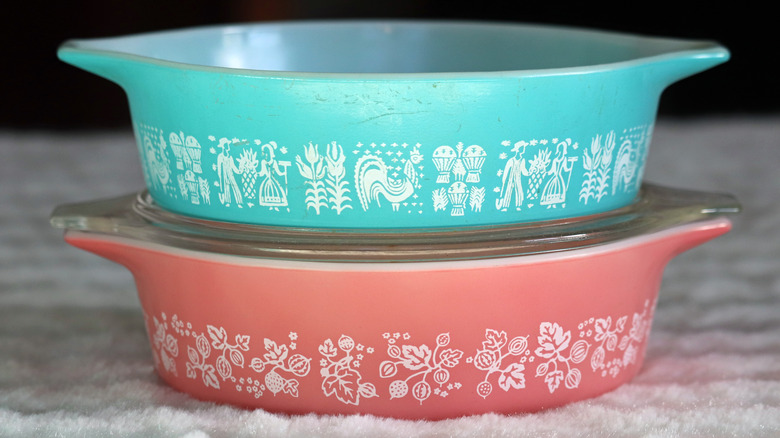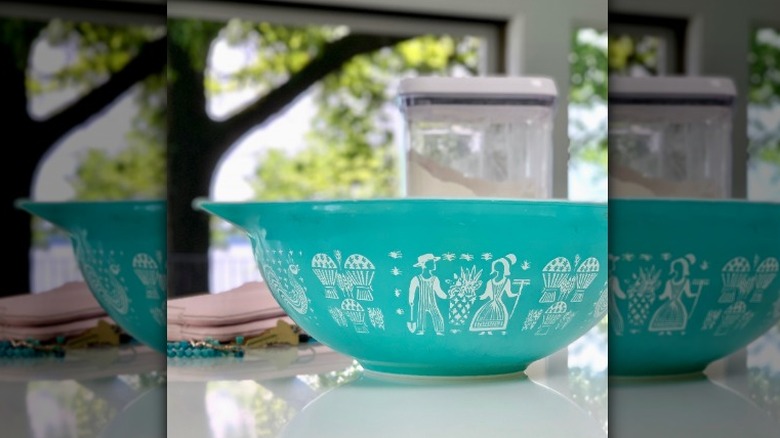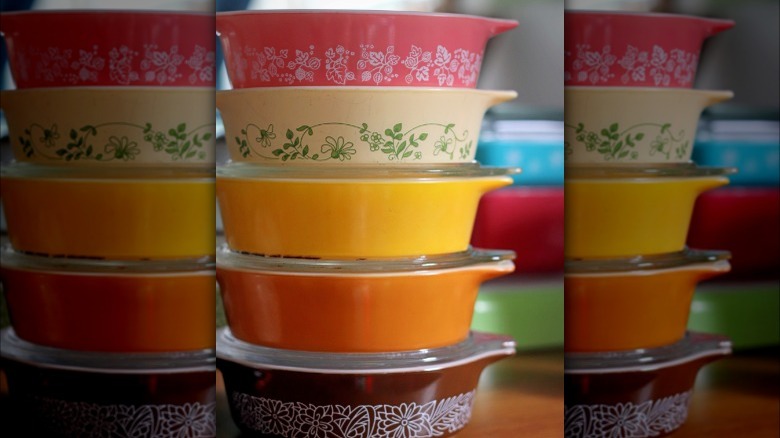Why Vintage Pyrex Is So In Demand
Modern kitchen appliances like home espresso machines and Kitchen-Aid stand mixers are having a moment. Even in the contemporary home-cook-sphere, you'd be hard-pressed to find a kitchen without at least one Pyrex mixing bowl or casserole dish tucked into a cupboard somewhere. It's utilitarian glassware with unique patterns and an inherently American identity — an identity that has become far more complicated than a simple piece of cookware. Millennial and Gen Z home cooks are scouring estate sales, eBay, Craigslist, Goodwill, and other thrift stores for a Pyrex score. There are Pyrex Facebook groups with tens of thousands of members.
According to Antique Mall, the Corning Glass Works Company first introduced Pyrex kitchenware in 1915, but it has taken on a life of its own since then. Today, vintage Pyrex dishes with the rare Turquoise Diamond Pattern produced from 1953 to 1960 regularly fetch as much as $600 per piece. Most other collectible vintage Pyrex items fall somewhere in the $30-$400 range. So, what's all the hype about? Why is vintage Pyrex so in demand?
They don't make 'em like they used to (for real)
Pyrex dishes have Methuselah-esque longevity. That patterned mixing bowl can last you an entire lifetime, be handed down to your kid, then last them their entire lifetime, too. According to EatingWell, vintage Pyrex is made from a different material than the new stuff. How can foodies spot the difference? Capitalization. Products emblazoned with a lowercase "pyrex" label are made from soda-lime glass, a type of commercially-produced glass that isn't as heat resistant as other formulas. It's less expensive to produce and more easily malleable but doesn't hold up as well under high temperatures.
Products imprinted with the all-caps "PYREX" are made from borosilicate glass, a boron oxide and silica combo that's wicked durable and highly heat resistant. Borosilicate was what the Pyrex brand used when it first started selling its products — which, at the time, were imprinted with an uppercase label. Under the heat, borosilicate only expands 33% as much as other commercial glasses. According to reference librarian Regan Brumagen of the Corning Museum of Glass via Bon Appétit, what would be released to the public as Pyrex "opal wear" was originally commissioned by the U.S. Army. They asked Corning to make glass dishes durable enough that they could be thrown against the wall without breaking. Alas, Pyrex stopped making its products with borosilicate glass sometime during the late 1970s. If you spot an all-caps "PYREX" etched into that bowl, it's real vintage and real quality.
Different strokes for different folks
Pyrex glassware isn't the first time contemporary foodies have seen a resurgence of retro kitchenware or the "mid-century modern" aesthetic. Hop on Pinterest and search the words "retro kitchen" and you'll see what we mean. Take, for instance, Smeg, the Italian brand of designer kitchen appliances that emulate the style of '50s and '70s cookware. A rounded two-slice toaster runs for $239.95 at Williams-Sonoma, and a pastel fridge with just 9.01 cubic feet of space will set you back about $2,500.
Why are some consumers willing to pay so much for an aesthetic? Or spend upwards of $500 on a single rare Pyrex dish? The answer is: If you don't get it, then it's probably going to be impossible to explain it. Some folks gladly shell out money for eclectic homewares for the same reason other folks gladly shell out money for old broken muscle cars to restore, rare magazine issues or discontinued Looney Toon plushies. People like what they like. For others, it's all about nostalgia. Pyrex released 170 different patterns from 1956 to 1983, each with a whimsical name like Golden Honeysuckle, Lucky in Love, Pineapple Party, Cloverberry, and Angelfish. The kitsch is reminiscent of a simpler world and less complicated times — plus, in the case of Pyrex, the product is useful, holds up, and is marginally less likely to explode under your broiler.


